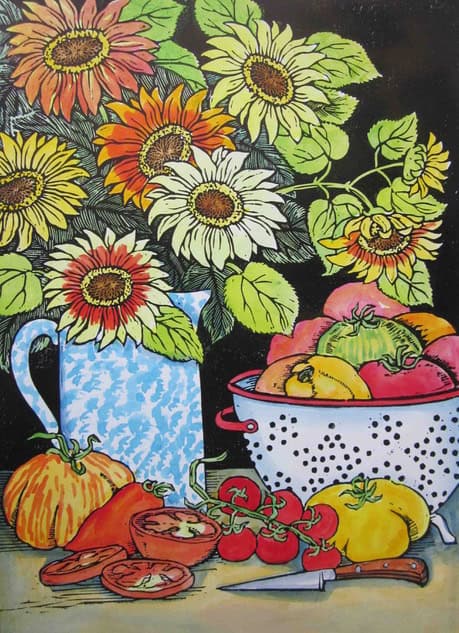ARTFUL KITCHEN GARDENS. I’ll admit that I get my best ideas while in the garden, and one day I realized that everything I knew about gardening, I actually learned in art school. Here’s my top 10 things I learned in art school, to help you stay organized and creative in in your kitchen garden.
 One: Start with a clean canvas.
One: Start with a clean canvas.
Soil is the key to your success. Tests are optional for the home gardener, but they are a good idea, for several reasons. You can buy soil test kits, though they are not as reliable as tests that are offered through your state’s USDA extension service to see if you have lead or other toxins before you start. Feed your soil with compost and care, and it will feed you.
Two: Get to know your materials.
A true kitchen garden is built on a wide range of vegetables, fruits, flowers, and herbs, combined in an aesthetic style. Knowing when to sow seeds, which ones are best to sow directly in the garden, and how to successfully germinate a range of varieties takes a bit of experience. It takes years to really get the rhythm of when to sow, but eventually you will get the hang of it and it will become second nature.
 Three: Follow the rules before you break them.
Three: Follow the rules before you break them.
Plants need sixteen different elements for life, growth, and reproduction. To be truly skillful at feeding your soil, you must be aware of what the major building blocks will do for your plants. Fertilizer and soil amendments often have three numbers that represent: nitrogen, phosphorous r and potassium. Learn what these mean and how they will improve your soil and the health of your plants.
Four: Maintain a neat workspace.
Weeds produce an enormous number of seeds, and one plant can quickly disperse baby weeds in profusion. To prevent weeds from taking over, keep the soil cultivated by gently running a hoe along the row between the plants to dislodge weed seedlings, as well as to aerate the soil so that it can more easily absorb water. Do this often, from early spring right through fall.
Five: Learn to draw a straight line.
Enclose the perimeters of your kitchen garden with a low stone wall, a boxwood hedge, a row of espaliered fruit trees, or a rustic split-rail fence. This will do more than simply keep out dogs and deer; a distinctive edging creates a border, as well as a transition that visually marks the boundary where the lawn ends and the garden begins. It is like putting a picture frame around your garden, to enhance its natural beauty.
 Six: Develop individual style.
Six: Develop individual style.
We often think of vegetables as ground-hugging plants, yet many ornamental edibles enjoy climbing, rambling, and spreading from above. Height is remarkably effective in creating drama in a kitchen garden design. Provide an assortment of trellis materials upon which pole beans, cucumbers, gourds, and tomatoes can grow upwards, creating a wonderful vertical tapestry in the garden landscape. I use simple bamboo poles harnessed together to form a tent or teepee.
Seven: Be observant. Explore the connections.
For many years, I watched honeybees from a distance until I became a “new-bee” beekeeper. I read about different types of honeybees to order, and found a beekeeping neighbor who became my mentor. The benefits go far beyond delicious honey. Old dormant fruit trees are now heavy with fruit, and three of my neighbors have become beekeepers, as well.
 Eight: Take care of your tools.
Eight: Take care of your tools.
Garden centers are like kitchen stores; they offer many more tools and gadgets than you actually need to get the job done. Some may look tempting, and they may offer time-saving techniques, but in the end they will only create clutter in your tool shed. Plan to invest in a set of good tools that you can rely on each season. Hang them up and bless them each fall.
Nine: Don’t be afraid to make mistakes.
Keep the rows straight and the borders trimmed, and keep trying new arrangements and variations of plants, but accept that perfection is unattainable. There are no mistakes in gardening, only opportunities to learn more. Start small—learn how to manage a compact space before launching into a larger garden.
Ten: Keep a sketchbook of ideas.
Get out and visit other gardens, take pictures, clip magazine articles, and read as much as you can about new plants and ways to combine them. Learn about European influences and American adaptations, and bring your own creative ideas back to your garden design.
![]() For more ideas on kitchen garden designs, check out my book: The Complete Kitchen Garden or download this Ellen Ogden Kitchen Garden Designs
For more ideas on kitchen garden designs, check out my book: The Complete Kitchen Garden or download this Ellen Ogden Kitchen Garden Designs


